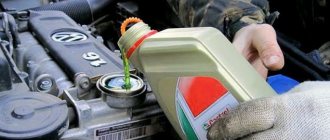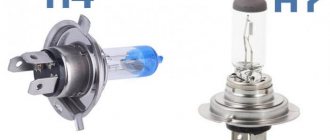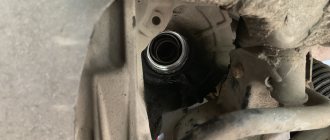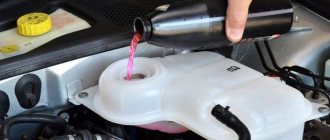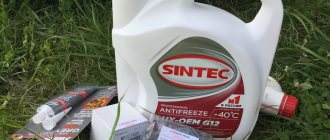Optimal operation of the Volkswagen Polo car engine is possible only in a narrow temperature range. To prevent overheating of the power unit, a cooling system is used. Its working fluid is antifreeze. Its condition determines the reliability of heat transfer from the engine to the radiator. In addition to deteriorating heat transfer, non-compliance of antifreeze with the manufacturer's requirements can lead to its freezing and defrosting of the cooling system circuit in the winter season.
Therefore, the coolant should be given due attention by the car owner.
Algorithm of actions when replacing coolant
If you study modern cars, their design often lacks a drain plug on the engine block. Because of this circumstance, the antifreeze is only partially drained, after which it is necessary to flush it. This will remove any remaining coolant.
In post-Soviet territories, the Polo sedan with a 1.6 engine capacity has gained popular popularity. It is on the example of this car that the procedure for replacing antifreeze will be considered. You can do everything on your own if you follow the sequence of steps.
How to replace the coolant with your own hands
Any owner of this car can independently change the antifreeze on the Polo Sedan if he has minimal experience in car repair and maintenance. Before starting the replacement, you must purchase ready-made antifreeze or concentrate. The second option is diluted with distilled water in the same proportion, i.e. to obtain 4.52 liters of finished liquid you will need 2.26 liters of concentrate and water. When replacing the refrigerant, flush the system with distilled water to completely remove any remaining antifreeze.
Draining antifreeze
The first thing to do is to place the vehicle on a platform so that you can easily remove the plastic boot on the engine. In a simple way it is called protection. In its usual form, it is secured with four bolts that need to be unscrewed. When the boot is removed, you should proceed directly to draining the liquid itself.
Algorithm of actions:
- In the lower left part of the radiator, in the direction of travel of the car, there is a thick hose. You can identify it by the spring clamp with which it is clamped. Using a special puller or pliers, you need to squeeze and move this clamp.
- An empty container is placed under this place, the hose is pulled back, directed into the container and the coolant is drained. The volume of the dishes into which the antifreeze will be released must contain at least 6 liters.
- We move up to the hood of the car. We open it, fix it and remove the plug from the expansion tank, which contains antifreeze. You should wait until the tank is completely empty.
- To dry the cooling system as much as possible, you can use a pump or compressor to apply pressure to the expansion tank. Thanks to this trick, you will be able to expel another liter of liquid.
All these actions allow you to drain +/- 4.5 liters of liquid. However, the total volume that the system holds is 5.6 liters. Accordingly, there is approximately another 1.2 liters in the engine. Removing its systems will no longer be so easy, which means you need to move on to flushing.
Leaks and other problems
The radiator itself leaks quite rarely. To diagnose, you need to contact a car service center, or by plugging the outlets, immerse the radiator in a container of water to detect air bubbles. They also use the pressure testing method - a special colored liquid is pumped into the radiator under pressure and they see where the leak is.
But leaky rubber tubes with microcracks are a much more common phenomenon; it is better to replace suspicious ones along with antifreeze.
Flushing the Volkswagen cooling system
From below the car, you need to put the previously removed hose back in place. To rinse, take distilled water and pour it into the tank 2-3 cm above the maximum mark. When heating begins, its level will become lower. If money allows, then flushing is done using concentrate.
After this, you need to get into the vehicle and start it. Wait until the engine is completely warmed up. If the sensor does not work, this can be determined by the following visual signs:
- The fan blower fan will operate at increased speed.
- The two radiator hoses will become uniformly hot.
After this, turn off the engine and allow it to cool slightly. Then drain the water in the same way as the antifreeze was removed. One time will not solve the problem, and therefore you need to rinse until the water coming out is clean. Most often you will have to wash it 2-3 times.
Engine flushing
- Drain the old fluid mixture
- Fill with clean water.
- Start the engine and wait until it idles for 2-3 minutes.
- Stop the engine and drain the water.
- Blow with compressed air from the side of the expansion tank.
- Pour new fluid into the engine cooling system. It is recommended to fill G12 Plus
According to the manufacturer, the liquid provides freeze protection down to -30 °C.
In the antifreeze/water ratio, the proportions must be 50/50.
Filling with antifreeze
Replacing antifreeze in a Volkswagen Polo sedan 1.6 requires the correct actions, because when adding fluid, it is important to do this without creating air pockets. Inexperienced car owners often encounter this problem when they perform this technical procedure on their own. Such an oversight can cause unstable engine operation. This is easy to notice, because after replacing the antifreeze, cold air will begin to blow from the stove, and the engine temperature will become higher than normal.
To fill in antifreeze without causing air pockets, you need to follow the following instructions:
- Open the hood.
- The pipe that goes to the air filter needs to be disconnected. This will allow you to get to the temperature sensor.
- We take out the temperature sensor. To do this, remove the retaining plastic half-ring. You need to pull towards the interior. Now the sensor can be removed without any problems.
- Take new antifreeze and fill it in until it begins to flow out from the place where the temperature sensor was located.
- Place the sensor in its original place and secure it with a retaining ring.
- The pipe that goes to the air filter is connected.
- Add antifreeze to the required mark on the tank and close it.
- Close the hood and start the engine, waiting for it to warm up completely.
Thanks to these instructions, replacing antifreeze on a Volkswagen Polo sedan will be done without air locks, which will ensure stable engine operation, eliminating overheating. After this, the stove will also blow hot air.
Experienced owners advise not to remove the temperature sensor, but simply pour antifreeze into the tank. After this, you need to check the stove by turning it on. If cold air is blowing, it means there is an air lock. This will also be indicated by the lit-up liquid temperature icon on the dashboard. To fix this problem, just start the engine with the expansion tank open.
Over the next 1-2 days, it is worth monitoring the level of antifreeze in the tank and, if necessary, adding it to the required level. This check will allow you to adjust the fluid level, which may become lower after the engine cools down.
Third stage of work
After cleaning the coolant, new fluid is poured in. According to the manufacturer's instructions, the concentrate is diluted with distilled water. Some manufacturers produce diluted antifreeze. There is no need to dilute it.
Filling with new antifreeze is carried out only after the engine has warmed up at maximum power. Thanks to this, the liquid is evenly distributed throughout the cooling system, driving away air pockets.
Different brands of antifreeze also have different compositions. Such concentrates are most often incompatible. As a result, the liquid will disintegrate into salts and acids, which has a destructive effect on coolant parts. Therefore, it is not recommended to mix antifreeze of different colors and brands.
Regardless of the composition, the fluid should be replaced only after the engine has cooled down.
How often do you need to change antifreeze on a Volkswagen, and which one to choose?
On modern cars, the manufacturer uses antifreeze, which does not require replacement. However, car enthusiasts are not positive about this idea. Moreover, when the antifreeze changes its color or the age of the car exceeds 5 years.
Sooner or later, the car owner decides to replace the coolant, and then the question arises: “What should I use instead of the old one?” When replacing antifreeze in Polo Sedan 1.6, the manufacturer recommends using the concern’s own development - G13 C 013 A8J M1. It is available in concentrated form.
If you need a budget option, then you can use the analog Hepu P999-G13. It is also sold as a concentrate, but at a lower cost than the original from Volkswagen. If you have little experience in replacing fluid, you can use ready-made Coolstrem G13 antifreeze. This product is VAG approved.
Choosing antifreeze for Volkswagen Polo
The manufacturer recommends filling Volkswagen Polo with antifreeze G12, G12++, G13. Since 2012, cars leaving the production line have been filled exclusively with G13 coolant. Antifreeze meets all environmental tolerances and also has a propylene glycol base, which is not toxic.
Original VOLKSWAGEN G13 coolant
The manufacturer also produces a concentrate of coolant G13, which must be diluted with distilled water. Catalog numbers of the concentrated liquid and the finished mixture are presented in the table below.
Table - G13 concentrate for Volkswagen Polo
| Catalog number | Liquid volume |
| G013A8JM1 | 1.5 liters |
| G013A8JM8 | 60 liters |
| G013A8JM9 | 210 liters |
| Ready liquid G 013774M2 | 1.5 liters |
Among the good analogues of the original Volkswagen Polo coolant are Liqui Moly and Mobil 1. It is allowed to use non-original antifreeze from other manufacturers. It is important to ensure that the liquid meets tolerances G12, G12+, G12++, G13. Experts recommend using an original consumable for replacement, which was specially designed for the Volkswagen Polo. The stability and reliability of the engine, as well as its durability, depend on the selected fluid.
Level control and required volume
When replacing antifreeze, it is necessary to take into account the volume of the cooling system, since pouring excessive amounts of liquid is not recommended. The system of cars manufactured before November 2015, as well as later versions with a new engine of 110 and 90 horsepower, contains 4.52 liters of fluid. On cars with 1.4 liter 125 l/s engines, the system capacity is larger; 7.03 liters of coolant are poured into it.
To check how much antifreeze is in the system, cool the engine, open the hood and find the spherical reservoir, which is located in the engine compartment on the right wheel arch. On the side surface of the tank there are marks for the minimum and maximum liquid levels. Under normal operating conditions, the amount of refrigerant should be between these marks. If the level drops, it is necessary to restore it and check the tightness of the system. You can only top up the antifreeze that was filled in earlier.
The author of the video, Konstantin Sabirov, will tell you how to add refrigerant to a Volkswagen Polo.
Replacement frequency
The service life of the fluid before replacement varies from 3 to 5 years. The use of antifreeze is limited to a mileage of 90 thousand km. It is recommended to replace any element of the cooling system with the addition of new antifreeze. For example, adding coolant is required when installing a new pump or radiator. An unscheduled replacement of antifreeze is necessary in the following cases:
- premature aging of liquid;
- mixing antifreeze with engine oil;
- constant overheating of the system;
- mixing two different antifreezes;
- the appearance of foreign odors;
- loss of its original properties by the liquid.
Volkswagen Polo Sedan Interlagos › Logbook › Topping up G13 antifreeze. Where does antifreeze go?
Greetings to everyone who visited my logbook.
Today we will talk about the next addition of antifreeze. It so happened that the antifreeze level began to drop again. First up to the Min mark, then after winter and even more so below the minimum mark.
— The first time I was topped up with antifreeze was at the OD at TO-1 (7,545 km).
I can’t say that this was a forced measure. The level in the tank was in the middle. The dealer carried out the procedure for adding antifreeze only to extract money. In general, they added antifreeze to me, according to the documents, 300 ml. A blatant lie. At the level I had then, no more than 100 ml would have entered. They charged as much as 300 rubles for refilling. (for comparison, a bottle of VAG concentrate costs 600 rubles). Moreover, the antifreeze was poured above the maximum mark, about a centimeter. I asked why they did this. In response, they waved it off, saying that the level would level out and the excess would spill out. Well, yes, of course, because the client pays for these excesses. Complete nonsense. I forgot about it and moved on. The level actually went down, almost a year later. But it was within the acceptable zone.
— The second time topping up antifreeze was required at a mileage of 25,000 km, just before TO-3, in the spring of 2016.
This time the level dropped a full centimeter below the Min mark. I’ll say right away that at about 20,000 km the antifreeze level was exactly at the Min mark. It dropped below the minimum after the winter. Possibly due to temperature changes. When warming up in winter, when starting a cold engine, I noticed some gurgling and gurgling noises. It was the coolant bubbling in the expansion tank. It actually gurgled, although not very loudly. And you could even see how it was seething. I once wrote about this in the logbook. Adding antifreeze G13. See how the antifreeze bubbles in the tank in the video from the 2nd minute. Then I added 200-250 ml of antifreeze to the Max mark, so that OD Automir VW would not again have the desire to add antifreeze to me at a fabulous price.
— The third time topping up was required just over a year later, at a mileage of 34,000 km.
Again I observed that the level after winter dropped to the Min level. But somehow there was no time to top it up. I only topped it up at the end of May 2017. 200-250 ml came in, as usual.
Watch the video for the filling process itself.
Where does the antifreeze go?
I somehow never asked this question before. Well, the level is going down, and going down. But this year I was at the service center, they checked the steering rack (which, by the way, he soon repaired) and the suspension as a whole, and the master noticed that the pump was leaking
.
Of course, I had heard about the “very good” quality of components, in particular about the quality of the cooling pump on the VW Polo, but I could not believe that it was the pump that was the problem. But as I looked at it myself later, the pump was really snotty. Splashes are noticeable on the right side member. And the spar itself in this place is covered with a film formed from antifreeze and the eroded standard wax coating of the body. The technician recommended replacing the pump immediately, as antifreeze could leak out. Well, of course. They had a pump in stock and were itching to replace something and make money. By the way, on that day replacing the pump would have cost me 1300 + 1100 rubles = 2400 rubles. + naturally antifreeze for topping up. I absolutely did not want to replace the pump with a new one.
. Why didn't you want to? Yes, because the pump did not make any extraneous sounds, it did not crack, and the leak was not that critical. In a year or a year and a half, only 200-250 ml is poured out. I decided to just top it up and watch. If rustling or crackling noises appear, I will immediately replace the pump with a new one.
Which pump to choose?
Of course, it’s up to you to decide, I’ll give you possible options. I’ll say right away that I don’t see the point in the original. Moreover, if this original leaks on such children's runs. The original makes sense if you have to replace your pump under warranty, in which case the dealer will give it a 2-year warranty. But this is for those who have 40-50 thousand miles per year. Not our case for sure. Analogues are in no way inferior in quality, and sometimes even surpass the original. After all, in fact, no one knows who the actual manufacturer of the original pump is. Maybe some Chinese factory? Or maybe not. Although we live in an age of optimization and cheaper production.
For topping up:
1) Concentrate G13 VAG 1.5l -
G013A8JM1
- 488 rubles (price as of July 2022) (Ready diluted mixture G13 VAG -
G013774M2
- 342 rubles) 2) Distilled water Expert 1l - 39 rubles.
And here's what the pump itself looks like.
I haven't bought a pump yet.
But something tells me that it would be good to buy it and put it in the trunk along with a set of replacement keys. You never know...
Since I had previously bought a canister of VAG G13 concentrate and distilled water, this time the cost of refilling was reduced to a minimum.
Antifreeze for Volkswagen Polo 5th generation
| Year | Engine | Type | Color | Lifetime | Recommended Manufacturers |
| 2010 | petrol, diesel | G12 | red | 5 years | Havoline, AWM, G-Energy |
| 2011 | petrol, diesel | G12 | red | 5 years | Havoline, MOTUL Ultra, Freecor, AWM |
| 2012 | petrol, diesel | G12 | red | 5 years | Havoline, AWM, G-Energy, Freecor |
| 2013 | petrol, diesel | G12 | red | 5 years | Frostschutzmittel A, VAG, FEBI, Zerex G |
To make the right purchase you only need to know the Type
and
The color
(shade) of antifreeze allowed for a specific year of manufacture of the body.
The same type
of antifreeze can be produced in different colors; the table shows such cases.
When completely changing the fluid, it is enough to know only the Type
suitable antifreeze.
If topping up is necessary, it is also important to find out the color of
the liquid already filled. Select the manufacturer at your discretion. Do not forget - each type of liquid has its own service life.
For example:
For Volkswagen Polo (5th generation) 2010, with a gasoline or diesel engine, suitable - Carboxylate antifreeze class, type G12 with shades of red. The approximate period of the next replacement will be 5 years.
Required Tools
In order for the coolant replacement on a Volkswagen Polo to be successful, the car owner will need a set of tools and materials, which are listed in the table below.
Table - Tools and materials needed to replace antifreeze
| Tools and materials | Note |
| Torx head T-25 | If the car has plastic protection |
| Ratchet | With a set of heads |
| Pliers | You can use pliers. The tool is required to remove the spring clamp from the hose. |
| Container for draining antifreeze | Volume 6 - 7 liters |
| Distilled water | Liquid volume from 5 to 15 liters |
You cannot fill a Volkswagen Polo with pure coolant concentrate. To prepare the coolant, the car owner will need a container, a measuring cup and distilled water.
The cooling system of Volkswagen Polo with 110 and 90 liter engines includes 4.6 liters of liquid. 1.4 liter and 125 liter engines consume 7 liters of antifreeze.
The proportion in which concentrate and water must be mixed to obtain finished antifreeze is 40:60. It is also permissible to dilute the concentrate 1:1. This liquid will not harm the cooling system, but will only increase the consumption of concentrated antifreeze.
Level control and required volume
When replacing antifreeze, it is necessary to take into account the volume of the cooling system, since pouring excessive amounts of liquid is not recommended. The system of cars manufactured before November 2015, as well as later versions with a new engine of 110 and 90 horsepower, contains 4.52 liters of fluid. On cars with 1.4 liter 125 l/s engines, the system capacity is larger; 7.03 liters of coolant are poured into it.
To check how much antifreeze is in the system, cool the engine, open the hood and find the spherical reservoir, which is located in the engine compartment on the right wheel arch. On the side surface of the tank there are marks for the minimum and maximum liquid levels. Under normal operating conditions, the amount of refrigerant should be between these marks. If the level drops, it is necessary to restore it and check the tightness of the system. You can only top up the antifreeze that was filled in earlier.
The author of the video, Konstantin Sabirov, will tell you how to add refrigerant to a Volkswagen Polo.
Price issue
The cost of replacing antifreeze on your Polo Sedan yourself will include the price of only two components - refrigerant costing from 690 to 720 rubles. for a container of 5 liters and distilled water - about 150 rubles. for three canisters with a capacity of 5 liters each. When filling with G13 fluid, the cost will be 1,500 rubles. for the finished liquid and about 1 thousand rubles. for concentrate. To this amount you must also add the price of distilled water. The total cost of replacing the refrigerant with your own hands will not exceed 2 thousand rubles.
Changing the coolant at service centers will cost the car owner 3-4 thousand rubles.

